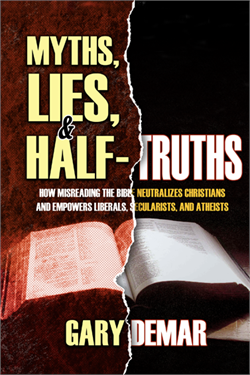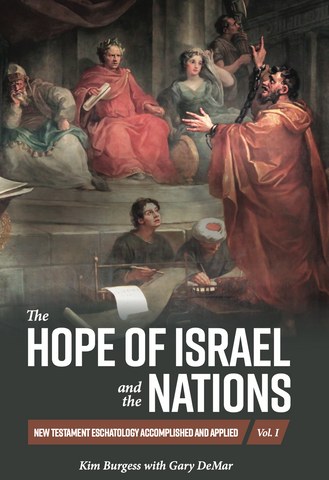An image of Isaiah 13 from the Bible with some highlighted verses was posted on Facebook followed by a comment that stated that “the wrath of God is coming on the world,” that is, our world that was 2700 years in the future from the time the prophecy was given to Isaiah. Of course, God hasn’t stopped with judging the world when He sent Israel and Judah into captivity or with Babylon, the Medes and Persians, Greece, Israel in AD 70, and the Roman Empire. God continues to judge the world.
Before any fulfilled prophecy can be applied, the original context must be understood. What is God describing in Isaiah 13, and when will it be fulfilled? He is not describing an end-time dispensational gap theology that includes a pre-tribulational rapture of the church, a seven-year-period separated from the 69 weeks of years (483 years) to be ruled by the Antichrist supposedly described to Daniel in Daniel 9:24-27, etc. When dispensational commentators are consulted, this is what they have in mind. Amillennialists often offer similar interpretations but without the gaps. Like dispensationalists, their timing indictors are ignored or misapplied.
It’s not wrong to refer to past historical judgments to call on people and nations to repent. Paul did it in Acts 17:31 when he told the Athenians that God was “about to [μέλλει/mellei] judge the oikoumenē” (translated as “world” in most translations), that is, their world! Let’s not forget what Jesus said to His disciples:
“For the Son of Man is about to [μέλλει/mellei] come in the glory of His Father with His angels and WILL THEN REPAY EVERY MAN ACCORDING TO HIS DEEDS. Truly I say to you, there are some of those who are standing here who will not taste death until they see the Son of Man coming in His kingdom” (Matt. 16:27-28).
When these soon to take place judgments happened, God’s judgment was neither postponed nor stopped. They serve as warnings as Paul stated in 1 Corinthians 10:11: “Now these things happened to them [Old Covenant Israel] as an example [τύπος/type], and they were written for our instruction, upon whom the ends of the ages have arrived.” The “our instruction” refers to the people in Paul’s day related to the upcoming judgment on first-century Israel that took place in the lead up to and including the destruction of Jerusalem that happened in AD 70. All generations can learn from Israel’s moral mistakes as well as the moral mistakes of Rome, the French Revolution, the Soviet Union, Nazi Germany, and modern-day United States. No one is exempt from God’s judgment.
Now back to Isaiah 13 that’s a prophecy about the destruction of Old Testament Babylon. The first verse gives us the context: “The pronouncement concerning Babylon which Isaiah the son of Amoz saw.” Note the timing on that judgment: “Wail, for the day of the LORD is near! (v. 6) to “destroy the whole land” (v. 5). De-creation language was used to describe a coming judgment on the Babylonian empire (vv. 9-10).
Behold, the day of Yahweh is coming,
Cruel, with fury and burning anger,
To make the land a desolation;
And He will exterminate its sinners from it.
For the stars of heaven and their constellations
Will not flash forth their light;
The sun will be dark when it rises
And the moon will not shed its light.
That world of Babylonian rule, not our world. The day of judgment for Babylon was near. There is no indication that there is a gap of 2600 or more years between verses 10 and 11.
Here are additional OT examples of de-creation language in conjunction with the fall of nations:
Edom’s judgment:
“And all the host of heaven will wear away, and the sky will be rolled up like a scroll; all their hosts will also wither away as a leaf withers from the vine, or as one withers from the fig tree” (Isa. 34:4).
Egypt’s judgment:
“And when I extinguish you, I will cover the heavens and darken their stars; I will cover the sun with a cloud and the moon will not give its light. All the shining lights in the heavens I will darken over you and will set darkness on your land,” declares the Lord God” (Ezek. 32:7-8).
There are more examples of de-creation language among the OT prophets (Ps. 18; Isa. 51:6; Jer. 4:24; 15:9; Amos 5:20; 8:9; Joel 2:31; Zeph. 1:14-16; Mal. 4:1, 5) and the NT (Matt. 21:21; 24:29; Rev. 6:12-14; 8:8, 12; 12:4; 18:21). David Chilton comments:
As the sixth Seal is broken (Revelation 6:12-14), we are more clearly brought into the events of Israel’s “last days.” The Lamb reveals the next great aspect of His covenantal judgments, in a symbol often used in Biblical prophecy: de-creation. Just as the salvation of God’s people is spoken of in terms of creation (cf. II Corinthians 4:6; 5:17; Ephesians 2:10; 4:24; Colossians 3:10), so God’s judgments (and the revelation of His presence as Judge over a sinful world) are spoken of in terms of de-creation, the collapse of the universe—God ripping apart and dissolving the fabric of creation. Thus St. John uses the fundamental structures of creation in describing the fall of Israel.[1]
When I pointed out to the Facebook poster that Isaiah’s de-creation language referred to OT Babylon, he responded with the following:
Primarily aimed at Babylon, I agree. However, the NIV and other translations use the term “world” which would refer to current days.
The use of “world” does not always mean the whole wide world even when a kingdom like Babylon considered itself to be the center of the whole world. The “Babylonian world map” is “the map of the cosmos symbolically featuring Babylon as the center of the universe and intentionally connecting them to a higher realm from which they drew meaning for their existence.” (Source)
There are numerous definitions of “world” in common speech and the Bible. In the New Testament, the Greek word kosmos can designate the entire created order (Matt. 13:35; 24:21; Luke 11:50; John 17:5, 24), the earth in particular (Matt. 4:8; Mark 14:9; Luke 12:30; John 11:9), a large group (John 12:19), a political/social/religious system (Rev. 11:15), a competing world system (1 John 5:19), and the world in which people live at a particular point in time.[2]

Myths, Lies, and Half-Truths
Christianity's failure to show itself practical in the past 150 years has guaranteed the success of secularism and militant Islam, both of which are doing incalculable harm at home and abroad. The rejection of any type of this worldly application of the Bible has resulted in the proliferation of man-centered worldviews that have steadily drained the life out of our world and left behind a spiritual vacuum.
Buy NowThe Pharisees were concerned enough about Jesus’ impact on the hearts and minds of the Jews, especially in the capital city of Jerusalem, that they issued this frantic warning: “The world [κόσμος/kosmos] has gone after Him” (John 12:19; cf. 7:4; 14:22; 16:21; 18:20). How can it be “that friendship with the world is hostility toward God” (James 4:4) when we know that “God so loved the world” (John 3:16)? If “world” is given the same meaning in every context in which it appears, then we would have a contradiction. Paul wrote, “I thank my God through Jesus Christ for you all, because your faith is being proclaimed throughout the whole world [κόσμῳ/kosmō]” (Rom. 1:8). In Colossians 1:23, Paul wrote, “if indeed you continue in the faith firmly established and steadfast, and not moved away from the hope of the gospel that you have heard, which was proclaimed in all creation under heaven, and of which I, Paul, was made a minister.” Even though the word “world” is not used, the passage gives the impression that the planet at that time had heard the gospel.
The judgment on Babylon was a judgment on the world at that time. The Septuagint (LXX), the Greek translation of the Hebrew Scriptures translates the Hebrew תֵּבֵל (tay-bale’) in Isaiah 13:11 (translated as “world” in the NIV) as τῇ οἰκουμένῃ, the same Greek word used in Matthew 24:14, Luke 2:1, Acts 11:28; 17:6, Revelation 3:10 and elsewhere that means no more than the world empire at that time.
This is from Joseph Benson’s commentary:
“Isaiah 13:11-16. I will punish the world — The Babylonish empire, which is called the world, as the Roman empire afterward was, (Luke 2:1,) because it was extended to a great part of the world, and because it was very populous, and Babylon itself looked more like a world than one city.
This is from Albert Barnes’ Commentary:
And I will punish the world — By the ‘world’ here is evidently meant the Babylonian empire, in the same way as ‘all the world’ in Luke 2:1, means Judea; and in Acts 11:28, means the Roman empire. Babylonia, or Chaldea, was the most mighty empire then on earth, and might be said to comprehend the whole world.
This is from Matthew Poole’s commentary:
The world; the Babylonish empire, which is called the world, as the Roman empire afterward was, Luke 2:1, because it was extended to a great part of the world, and because it was vastly populous, and Babylon itself looked more like a world than one city.
This is from John Gill’s commentary:
And I will punish the world for their evil — Not the whole world, but the kingdom of Babylon, so called because of its large extent, and the number of its inhabitants, just as the Roman empire is called the whole world, Luke 2:1 “evil” may be meant, either of the evil of sin, which was the cause of punishment, or else of the evil of punishment itself; and the sense be this, I will visit, or, in a way of visitation, I will bring evil, or evils, upon the world.
This is from Adam Clarke’s commentary:
I will punish the world “I will visit the world” — That is, the Babylonish empire; as ῇ οικουμενη, for the Roman empire, or for Judea, Luke 2:1; Acts 11:28. So the universus orbis Romanus [the whole Roman world], for the Roman empire;
This is from John Calvin’s commentary:
And I will visit upon the world wickedness. Here the Prophet does not speak of the whole world; but as Babylon was the seat of the most powerful of all monarchies, he gives to it on that account the name of the world, and he does so emphatically, (emphatikos) for Babylon was a kind of world, because it appeared to occupy nearly the whole earth.
In addition, J. Alec Motyer in The Prophecy of Isaiah: An Introduction and Commentary understandsתֵּבֵל (tay-bale’) as “the inhabited world.”[3] Here are some other examples:
• Henry Cowles, in his commentary Isaiah With Notes writes, “‘Punish the world for their iniquity’ conceives of the great Chaldean empire as embracing most of the world then known to the Jews. Thus ancient authors called the Roman empire ‘the whole world.’”[4]
• “World is here applied to the Babylonian empire, as embracing most of the known world” (J. A. Alexander, 1851).
• “The world.] i. e. The Land, or the Sinners of Babylon” (William Day, 1654).
• “The world, which God declares that he would punish, must be understood in a limited sense, as in many other prophecies to signify the large portion of the inhabited earth which was subject to the Babylonian empire, whose territories were very extensive. In the same manner, the Roman empire is called the whole world in the New Testament” (Robert Macculloch, 1794).
• “So the Roman empire and the world are often confounded together, as nearly equivalent terms” (T.R. Birks, 1871).
• “‘I will visit the world’] That is, the Babylonish empire: as ῇ οἰκουμένῃ, for the Roman empire, or for Judea; Luke ii. 1. Acts xi. 28” (Robert Lowth, 1836).
How would the people of Isaiah’s day have understood the prophecy revealed to Isaiah? To that first audience, Babylon meant Babylon. Jesus appropriates Isaiah’s judgment language and applies it to the New Covenant Babylon—Israel. He does this in Matthew 24:29. John is given a revelatory application in Revelation 17-18 where Babylon was Israel as well as Sodom and Egypt (11:8). Fulfilled prophecy has not lost its power. It’s a reminder that God is our Judge and Savior. What we should not do is create an entirely new prophetic system to accommodate the belief that there are two peoples of God and that Jesus failed in His redemptive mission. He did not. See American Vision’s new book The Hope of Israel and the Nations: New Testament Eschatology Accomplished and Applied.

The Hope of Israel and the Nations
The reader and student of the Bible must first understand the content of the New Testament writings in terms of how those in the first century would have understood it. The New Testament is written against the background of the Old Testament. The shadows of the Old were fulfilled in the reality of the New. All the rituals and ceremonies were fulfilled in Jesus. The same is true of the temple, land, blood sacrifices, the nature of redemption, the resurrection of the dead, the breaking down of the dividing wall dividing Jews and Gentiles, and so much more. The New Testament's emphasis is on the finished work of Jesus and its application, not only to that Apostolic generation but to the world today.
Buy Now[1] The Great Tribulation (Dallas, GA: Dominion Press [1987] 2024), 83. This reprint will be available soon from American Vision.
[2] See Gary DeMar, Myths, Lies, and Half-Truths (Powder Springs, GA: American Vision, 2010), chaps. 1 and 2.
[3] (Downers Grove, IL: InterVarsity Press, 1993), 138.
[4] (New York: D. Appleton and Company, 1880), 107.

